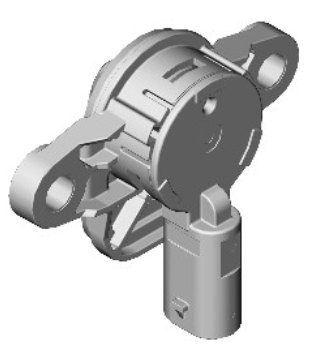Land Rover Discovery: Passenger Airbag Deactivation Indicator
.12.jpg)
- Passenger airbag deactivation warning indicator
The Passenger Airbag Deactivation (PAD) warning indicator is installed in the front overhead console. When appropriate, the indicator illuminates to advise front seat occupants that the passenger airbag is disabled. Operation of the indicator is controlled by the Restraints Control Module (RCM) connecting/disconnecting a ground signal from the indicator. The RCM illuminates the indicator when:
- There is a fault with the passenger airbag firing circuits.
- The passenger airbag is disabled in the Instrument Cluster (IC) set-up menu and the front passenger seat is occupied (all except NAS, Australia and Japan).
- Required by the occupant classification system (NAS only).
AIRBAG WARNING INDICATOR
.13.jpg)
Operation of the airbag warning indicator in the Instrument Cluster (IC) is controlled by a High Speed (HS) Controller Area Network (CAN) powertrain bus systems message from the Restraints Control Module (RCM). The RCM sends the signal to illuminate the airbag warning indicator if a fault is detected, and for approximately 6 seconds during the bulb check at the beginning of each ignition cycle.
IMPACT PRESSURE SENSOR

An impact pressure sensor is installed in each front door, attached to the door closing panels. The pressure sensors allow the Restrains Control Module (RCM) to detect any sudden pressure pulse that occurs in the front door during a side impact.
IMPACT SENSOR
.15.gif)
Impact sensors are installed in the front and both sides of the vehicle. The two front impact sensors are attached to the front end carrier, behind the inboard edge of each headlamp. The side impact sensors are attached to the base of each C/D pillar and to the inner panel of each rear quarter wheel housing, adjacent to the rear door latch strikers.
The impact sensors are accelerometers that allow the Restraints Control Module (RCM) to detect the sudden vehicle acceleration that occurs during an impact.
PRETENSIONERS
.16.gif)
- Seatbelt retractor and pretensioner (all except North American Specification (NAS) passenger seatbelt)
- Seatbelt retractor, pretensioner and load limiter (NAS passenger seatbelt only)
A pyrotechnic pretensioner is integrated into each seatbelt retractor. The pretensioners are used to tighten the seatbelts during a collision to ensure the occupants are securely held in their seats.
When operated by the Restraints Control Module (RCM), the pretensioners rotate the spool holding the end of the webbing to tighten the seatbelt.

